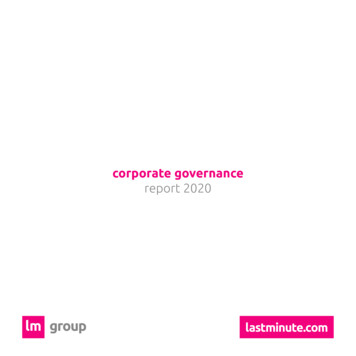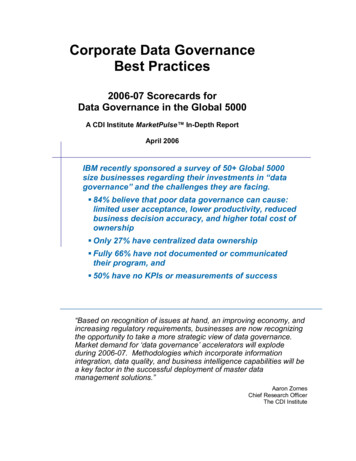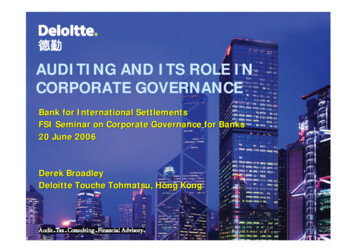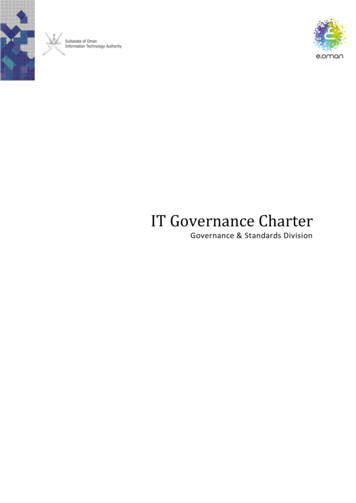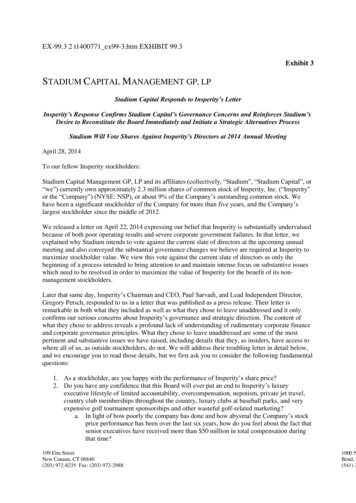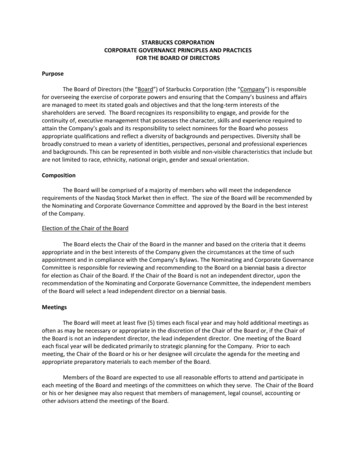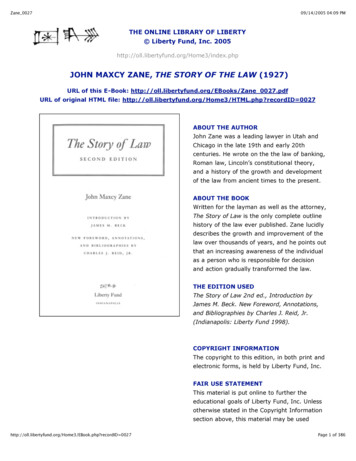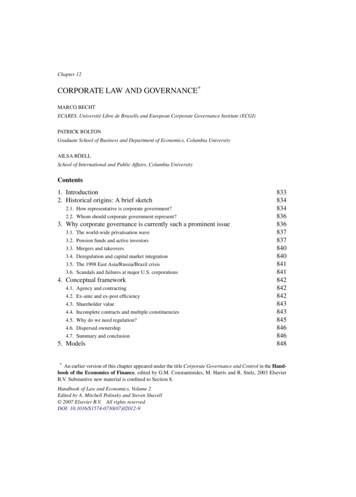
Transcription
Chapter 12CORPORATE LAW AND GOVERNANCE*MARCO BECHTECARES, Université Libre de Bruxells and European Corporate Governance Institute (ECGI)PATRICK BOLTONGraduate School of Business and Department of Economics, Columbia UniversityAILSA RÖELLSchool of International and Public Affairs, Columbia UniversityContents1. Introduction2. Historical origins: A brief sketch2.1. How representative is corporate government?2.2. Whom should corporate government represent?3. Why corporate governance is currently such a prominent issue3.1. The world-wide privatisation wave3.2. Pension funds and active investors3.3. Mergers and takeovers3.4. Deregulation and capital market integration3.5. The 1998 East Asia/Russia/Brazil crisis3.6. Scandals and failures at major U.S. corporations4. Conceptual framework4.1. Agency and contracting4.2. Ex-ante and ex-post efficiency4.3. Shareholder value4.4. Incomplete contracts and multiple constituencies4.5. Why do we need regulation?4.6. Dispersed ownership4.7. Summary and conclusion5. 3843845846846848* An earlier version of this chapter appeared under the title Corporate Governance and Control in the Handbook of the Economics of Finance, edited by G.M. Constantinides, M. Harris and R. Stulz, 2003 ElsevierB.V. Substantive new material is confined to Section 8.Handbook of Law and Economics, Volume 2Edited by A. Mitchell Polinsky and Steven Shavell 2007 Elsevier B.V. All rights reservedDOI: 10.1016/S1574-0730(07)02012-9
830M. Becht et al.5.1.5.2.5.3.5.4.Takeover modelsBlockholder modelsDelegated monitoring and large creditorsBoard models5.5. Executive compensation models5.6. Multi-constituency models5.6.1. Sharing control with creditors5.6.2. Sharing control with employees6. Comparative perspectives and debates6.1. Comparative systems6.2. Views expressed in corporate governance principles and codes6.3. Other views7. Empirical evidence and practice7.1. Takeovers7.1.1. Incidence of hostile ction of inefficienciesRedistributionTakeover defencesOne-share-one-voteHostile stakes and block salesConclusion and unresolved issues7.2. Large investors7.2.1. Ownership dispersion and voting control7.2.2. Ownership, voting control and corporate performance7.2.3. Share blocks and stock market liquidity7.2.4. Banks7.3. Minority shareholder action7.3.1. Proxy fights7.3.2. Shareholder activism7.3.3. Shareholder suits7.4. Boards7.4.1. Institutional differences7.4.2. Board independence7.4.3. Board composition7.4.4. Working of boards7.4.5. International evidence7.5. Executive compensation and careers7.5.1. Background and descriptive mance sensitivityAre compensation packages well-designed?Are managers paying themselves too much?Implicit 5895896897898898899899900900900900901902903905905
Ch. 12:Corporate Law and Governance7.6. Multiple constituencies7.6.1. Debtholders7.6.2. Employees8. Recent developments8.1. Regulatory responses to corporate scandals8.1.1. The Sarbanes-Oxley act8.1.2. Other U.S. reforms8.1.3. Eliot Spitzer and conflicts of interest on Wall Street8.1.4. European reforms8.2. Executive compensation and earnings manipulation8.3. Reforming the board of directors8.4. Other major research themes8.4.1. Corporate governance and serial acquisitions8.4.2. Stock returns and corporate governance8.4.3. Corporate governance and ownership structure8.4.4. Shareholder activism and fund voting patterns8.4.5. Corporate governance and the media8.4.6. Corporate governance and taxes9. 913915916916917917918918919919920AbstractThis chapter surveys the theoretical and empirical research on the main mechanismsof corporate law and governance, discusses the main legal and regulatory institutionsin different countries, and examines the comparative governance literature. Corporategovernance is concerned with the reconciliation of conflicts of interest between various corporate claimholders and the resolution of collective action problems amongdispersed investors. A fundamental dilemma of corporate governance emerges from thisoverview: large shareholder intervention needs to be regulated to guarantee better smallinvestor protection; but this may increase managerial discretion and scope for abuse.Alternative methods of limiting abuse have yet to be proven effective.
832KeywordsCorporate governance, ownership, takeovers, block holders, boardsJEL classification: G32, G34M. Becht et al.
Ch. 12:Corporate Law and Governance8331. IntroductionAt the most basic level a corporate governance problem arises whenever an outside investor wishes to exercise control differently from the manager in charge of the firm.Dispersed ownership magnifies the problem by giving rise to conflicts of interest between the various corporate claimholders and by creating a collective action problemamong investors.1Most research on corporate governance has been concerned with the resolution ofthis collective action problem. Five alternative mechanisms may mitigate it: (i) partialconcentration of ownership and control in the hands of one or a few large investors,(ii) hostile takeovers and proxy voting contests, which concentrate ownership and/orvoting power temporarily when needed, (iii) delegation and concentration of controlin the board of directors, (iv) alignment of managerial interests with investors throughexecutive compensation contracts, and (v) clearly defined fiduciary duties for CEOstogether with class-action suits that either block corporate decisions that go against investors’ interests, or seek compensation for past actions that have harmed their interests.In this survey we review the theoretical and empirical research on these five mainmechanisms and discuss the main legal and regulatory institutions of corporate governance in different countries. We discuss how different classes of investors and otherconstituencies can or ought to participate in corporate governance. We also review thecomparative corporate governance literature.2The favoured mechanism for resolving collective action problems among shareholders in most countries appears to be partial ownership and control concentration in thehands of large shareholders.3 Two important costs of this form of governance have beenemphasised: (i) the potential collusion of large shareholders with management againstsmaller investors and, (ii) the reduced liquidity of secondary markets. In an attemptto boost stock market liquidity and limit the potential abuse of minority shareholderssome countries’ corporate law drastically curbs the power of large shareholders.4 Thesecountries rely on the board of directors as the main mechanism for co-ordinating shareholder actions. But boards are widely perceived to be ineffective.5 Thus, while minorityshareholders get better protection in these countries, managers may also have greaterdiscretion.1 See Zingales (1998) for a similar definition.2 We do not cover the extensive strategy and management literature; see Pettigrew, Thomas, and Whittington(2002) for an overview, in particular Davis and Useem (2002).3 See ECGN (1997), La Porta, Lopez-de-Silanes, and Shleifer (1999), Claessens, Djankov, and Lang (2000)and Barca and Becht (2001) for evidence on control concentration in different countries.4 Black (1990) provides a detailed description of the various legal and regulatory limits on the exercise ofpower by large shareholders in the U.S. Wymeersch (2003) discusses legal impediments to large shareholderactions outside the U.S.5 Gilson and Kraakman (1991) provide analysis and an agenda for board reform in the U.S. against thebackground of a declining market for corporate control and scattered institutional investor votes.
834M. Becht et al.In a nutshell, the fundamental issue concerning governance by shareholders todayseems to be how to regulate large or active shareholders so as to obtain the right balancebetween managerial discretion and small shareholder protection. Before exploring ingreater detail the different facets of this issue and the five basic mechanisms describedabove, it is instructive to begin with a brief overview of historical origins and earlywritings on the subject.2. Historical origins: A brief sketchThe term “corporate governance” derives from an analogy between the government ofcities, nations or states and the governance of corporations.6 The early corporate financetextbooks saw “representative government” (Mead, 1928, p. 31) as an important advantage of the corporation over partnerships but there has been and still is little agreementon how representative corporate governance really is, or whom it should represent.2.1. How representative is corporate government?The institutional arrangements surrounding corporate elections and the role and fiduciary duties of the board have been the central themes in the corporate governanceliterature from its inception. The dilemma of how to balance limits on managerial discretion and small investor protection is ever present. Should one limit the power ofcorporate plutocrats (large shareholders or voting trusts) or should one tolerate concentrated voting power as a way of limiting managerial discretion?The concern of early writers of corporate charters was the establishment of “corporatesuffrage”, where each member (shareholder) had one vote (Dunlavy, 1998). The aimwas to establish “democracy” by eliminating special privileges of some members andby limiting the number of votes each shareholder could cast, irrespective of the numberof shares held.7 However, just as “corporate democracy” was being established it wasalready being transformed into “plutocracy” by moving towards “one-share-one-vote”and thus allowing for concentrated ownership and control (Dunlavy, 1998).86 The analogy between corporate and political voting was explicit in early corporate charters and writings,dating back to the revolutionary origins of the American corporation and the first railway corporations inGermany (Dunlavy, 1998). The precise term “corporate governance” itself seems to have been used first byRichard Eells (1960, p. 108), to denote “the structure and functioning of the corporate polity”.7 Frequently voting scales were used to achieve this aim. For example, under the voting scale imposed by aVirginia law of 1836 shareholders of manufacturing corporations cast “one vote for each share up to 15, onevote for every five shares from 15 to 100, and one vote for each increment of 20 shares above 100 shares”(Dunlavy, 1998, p. 18).8 Voting right restrictions survived until very recently in Germany (Franks and Mayer, 2001). They are stillin use in Denmark, France, Spain and other European countries (Becht and Mayer, 2001).
Ch. 12:Corporate Law and Governance835In the U.S. this was followed by two distinct systems of “corporate feudalism”: first,to the voting trusts9 and holding companies10 (Cushing, 1915; Mead, 1903; Liefmann,1909, 1920) originating in the “Gilded Age” (Twain and Warner, 1873)11 and later tothe managerial corporation.12 The “captains of industry” in the trusts and hierarchical groups controlled the majority of votes in vast corporate empires with relativelysmall(er) amounts of capital, allowing them to exert product market power and leaving ample room for self-dealing.13 In contrast, the later managerial corporations werecontrolled mainly by professional managers and most of their shareholders were toosmall and numerous to have a say. In these firms control was effectively separated fromownership.14Today corporate feudalism of the managerial variety in the U.S. and the “captainof industry” kind elsewhere is challenged by calls for more “shareholder democracy”,a global movement that finds its roots with the “corporate Jacksonians” of the 1960s inthe U.S.159 Under a typical voting trust agreement shareholders transfer their shares to a trust and receive certificatesin return. The certificate holders elect a group of trustees who vote the deposited shares. Voting trusts werean improvement over pooling agreements and designed to restrict product market competition. They offeredtwo principal advantages: putting the stock of several companies into the voting trust ensured that the trusteeshad permanent control over the management of the various operating companies, allowing them to enforce acommon policy on output and prices; the certificates issued by the voting trust could be widely placed andtraded on a stock exchange.10 Holding companies have the purpose of owning and voting shares in other companies. After the passage ofthe Sherman Antitrust Act in 1890 many of the voting trusts converted themselves into New Jersey registeredholding companies (“industrial combinations”) that were identical in function, but escaped the initial roundof antitrust legislation, for example the Sugar Trust in 1891 (Mead, 1903, p. 44) and Rockefeller’s StandardOil in 1892 (Mead, 1903, p. 35).11 The “captains of industry” of this era, also referred to as the “Robber Barons” (Josephson, 1934; DeLong,1998), were the target of an early anti-trust movement that culminated in the election of Woodrow Wilson asU.S. President in 1912. Standard Oil was broken up even before (in 1911) under the Sherman Act of 1890 andconverted from a corporation that was tightly controlled by the Rockefeller clan to a managerial corporation.Trust finance disappeared from the early corporate finance textbooks (for example Mead, 1912 versus Mead,1928). In 1929 Rockefeller Jr. (14.9%) ousted the scandal ridden Chairman of Standard Oil of Indiana, whoenjoyed the full support of his board, only by a small margin, an example that was widely used for illustratinghow much the balance of power had swung from the “Robber Barons” to management (Berle and Means,1932, pp. 82–83, cited in Galbraith, 1967), another type of feudal lord.12 For Berle and Means (1930): “[the] “publicly owned” stock corporation in America. . . constitutes aninstitution analogous to the feudal system in the Middle Ages”.13 They also laid the foundations for some of the World’s finest arts collections, philanthropic foundationsand university endowments.14 This “separation of ownership and control” triggered a huge public and academic debate of “the corporateproblem”; see, for example, the Berle and Means symposia in the Columbia Law Review (1964) and theJournal of Law and Economics (1983). Before Means (1931a, 1931b) and Berle and Means (1930, 1932) thepoint was argued in Lippmann (1914), Veblen (1923), Carver (1925), Ripley (1927) and Wormser (1931); seeHessen (1983).15 Non-Americans often consider shareholder activism as a free-market movement and associated calls formore small shareholder power as a part of the conservative agenda. They are puzzled when they learn that
836M. Becht et al.As an alternative to shareholder activism some commentators in the 1960s proposedfor the first time that hostile takeovers might be a more effective way of discipliningmanagement. Thus, Rostow (1959) argued, “the raider persuades the stockholders foronce to act as if they really were stockholders, in the black-letter sense of the term, eachwith the voice of partial ownership and a partial owner’s responsibility for the electionof directors” (1959, p. 47). Similarly, Manne (1964) wrote, “vote selling [. . .] negativesmany of the criticisms often levelled at the public corporation” [1964, p. 1445]. As weshall see, the abstract “market for corporate control” has remained a central theme inthe corporate governance literature.2.2. Whom should corporate government represent?The debate on whether management should run the corporation solely in the interests ofshareholders or whether it should take account of other constituencies is almost as oldas the first writings on corporate governance. Berle (1931) held the view that corporatepowers are powers in trust for shareholders and nobody else.16 But, Dodd (1932) arguedthat: “[business] is private property only in the qualified sense, and society may properlydemand that it be carried on in such a way as to safeguard the interests of those whodeal with it either as employees or consumers even if the proprietary rights of its ownersare thereby curtailed” (Dodd, 1932, p. 1162). Berle (1932) disagreed on the groundsthat responsibility to multiple parties would exacerbate the separation of ownership andcontrol and make management even less accountable to shareholders.17There is nowadays a voluminous literature on corporate governance. On many key issues our understanding has improved enormously since the 1930s. Remarkably though,some of the main issues over which the early writers have been debating remain centraltoday.3. Why corporate governance is currently such a prominent issueWhy has corporate governance become such a prominent topic in the past two decadesor so and not before? We have identified, in no particular order, the following reasons:shareholder activism today has its roots in part of the anti-Vietnam War, anti-apartheid and anti-tobacco movements and has close links with the unions. In terms of government (of corporations) there is no contradiction.The “corporate Jacksonians”, as a prominent critic called them (Manning, 1958, p. 1489), are named after the7th U.S. President (1829–1937) who introduced universal male suffrage and organised the U.S. DemocraticParty that has historically represented minorities, labour and progressive reformers (Encyclopaedia Britannica, Jackson, Andrew; Democratic Party).16 Consequently “all powers granted to a corporation or to the management of a corporation, or to any groupwithin the corporation, whether derived from statute or charter or both, are necessarily and at all times exercisable only for the ratable benefit of all the shareholders as their interest appears”, Berle (1931).17 He seems to have changed his mind some twenty years later as he wrote that he was “squarely in favour ofProfessor Dodd’s contention” [Berle (1954)]. For a comprehensive account of the Berle-Dodd dialogue seeWeiner (1964) and for additional papers arguing both points of view Mason (1959). Galbraith (1967) in hisinfluential “The New Industrial State” took Dodd’s position.
Ch. 12:Corporate Law and Governance837(i) the world-wide wave of privatisation of the past two decades, (ii) pension fund reformand the growth of private savings, (iii) the takeover wave of the 1980s, (iv) deregulationand the integration of capital markets, (v) the 1998 East Asia crisis, which has putthe spotlight on corporate governance in emerging markets (vi) a series of recent U.S.scandals and corporate failures that built up but did not surface during the bull marketof the late 1990s.3.1. The world-wide privatisation wavePrivatisation has been an important phenomenon in Latin America, Western Europe,Asia and (obviously) the former Soviet block, but not in the U.S. where state ownershipof enterprises has always been very small. On average, since 1990 OECD privatisationprogrammes have generated proceeds equivalent to 2.7% of total GDP, and in somecases up to 27% of country GDP. The privatisation wave started in the U.K., which wasresponsible for 58% of OECD and 90% of European Community privatisation proceedsin 1991. Since 1995 Australia, Italy, France, Japan and Spain alone have generated 60%of total privatisation revenues.Inevitably, the privatisation wave has raised the issue of how the newly privatised corporations should be owned and controlled. In some countries, most notably the U.K.,part of the agenda behind the massive privatisation program was to attempt to recreatea form of “shareholder democracy”18 (see Biais and Perotti, 2002). In other countriesgreat care was taken to ensure the transfer of control to large shareholders. The issuessurrounding the choice of privatisation method rekindled interest in governance issues;indeed Shinn (2001) finds that the state’s new role as a public shareholder in privatisedcorporations has been an important source of impetus for changes in corporate governance practices worldwide. In general, privatisations have boosted the role of stockmarkets as most OECD sales have been conducted via public offerings, and this has alsofocused attention on the protection of small shareholders.3.2. Pension funds and active investorsThe growth in defined contribution pension plans has channelled an increasing fractionof household savings through mutual and pension funds and has created a constituencyof investors that is large and powerful enough to be able to influence corporate governance. Table 1 illustrates how the share of financial assets controlled by institutionalinvestors has steadily grown over the 1990s in OECD countries. It also highlights thedisproportionately large institutional holdings in small countries with large financialcentres, like Switzerland, the Netherlands and Luxembourg. Institutional investors in18 A state-owned and -controlled company is indirectly owned by the citizens via the state, which has a sayin the affairs of the company. In a “shareholder democracy” each citizen holds a small share in the widelyheld company, having a direct interest and—theoretically—say in the affairs of the company.
838Table 1Financial assets of institutional investors in OECD countriesValue assets billionU.S. 7.0169.1Canada332.8560.5Czech Republic –(1994) nds378.3671.2Assetgrowth1990–1996% .995.0550.0–100.0230.646.8127.9308.9 35.577.41.30.30.72.2–0.50.34.94.50.1 0.1 0.11.913.71.11.50.12.6Assets as %GDP1990% Pensionfunds 1996199649.383.8 36.324.339.4 3.044.4636.558.194.6 43.0–––55.667.1 25.233.257–54.883.136.549.9 5.56.528.5 41.65.7 –45.778.7 79.313.439.9 8.181.777.6 –4857.3 4.9926.8 2139.1 0.88.84.5133.4 169.1 55.2% Insurancecompanies1996% Invest.companies1996% of Assetsin equity1996% 95282391.90.10.40.6 0.10.40.23.71.8 0.1 0.1 0.10.68.30.4 0.1 0.12.1312326146661221121728M. Becht et al.
Ch. 12:Value assets billionU.S. 19901996New 24.968.62.737.5264.5302.9449.82.32,226.913, 382.1Total OECDMean OECD15,758.326,001.441.5–Assetgrowth1990–1996% TotalOECDassets1996–0.10.3 0.10.11.01.21.7 .6Assets as %GDP1990–% Pensionfunds 1996% Insurancecompanies1996% Invest.companies1996% of Assetsin equity1996% OECDequity19960.10.2 0.1 0.10.21.41.2 0239640248674049.383.826.333.624.922Corporate Law and GovernanceTable 1(Continued)Source: OECD (1999), Institutional Investors Statistical Yearbook 1998, Tables S.1., S.2., S.3., S.4., S.6., S.11 and own calculations.839
840M. Becht et al.the U.S. alone command slightly more than 50% of the total assets under managementand 59.7% of total equity investment in the OECD, rising to 60.1% and 76.3% respectively when U.K. institutions are added. A significant proportion is held by pensionfunds (for U.S. and U.K. based funds, 35.1% and 40.1% of total assets respectively).These funds are playing an increasingly active role in global corporate governance. Inthe U.S. ERISA19 regulations oblige pension funds to cast the votes in their portfolioresponsibly. This has led to the emergence of a service industry that makes voting recommendations and exercises votes for clients. The largest providers now offer globalservices.Japanese institutional investors command 13.7% of total institutional investor assetsin the OECD but just 8.3% of the equities. These investors are becoming more demanding and they are one of the forces behind the rapid transformation of the Japanesecorporate governance system. As a percentage of GDP, the holdings of Italian and German institutional investors are small (39.9% and 49.9% in 1996) and well below theOECD average of 83.8%. The ongoing reform of the pension systems in both countriesand changing savings patterns, however, are likely to change this picture in the nearfuture.203.3. Mergers and takeoversThe hostile takeover wave in the U.S. in the 1980s and in Europe in the 1990s, together with the recent merger wave, has also fuelled the public debate on corporategovernance. The successful 199 billion cross-border hostile bid of Vodafone for Mannesmann in 2000 was the largest ever to take place in Europe. The hostile takeovers inItaly (Olivetti for Telecom Italia; Generali for INA) and in France (BNP-Paribas; ElfAquitaine for Total Fina) have spectacularly shaken up the sleepy corporate world ofcontinental Europe. Interestingly, these deals involve newly privatised giants. It is alsoremarkable that they have not been opposed by the social democratic administrations inplace at the time. Understandably, these high profile cases have moved takeover regulation of domestic and cross-border deals in the European Union to the top of the politicalagenda.3.4. Deregulation and capital market integrationCorporate governance rules have been promoted in part as a way of protecting andencouraging foreign investment in Eastern Europe, Asia and other emerging markets.19 ERISA stands for the Employee Retirement Income Security Act of 1974.20 One note of caution. The figures for Luxemburg and Switzerland illustrate that figures are compiled onthe basis of the geographical location of the fund managers, not the origin of the funds under management.Judging from the GDP figures, it is very likely that a substantial proportion of the funds administered in theU.K., the U.S., Switzerland and the Netherlands belong to citizens of other countries. For governance thelocation of the fund managers matters. They make the investment decisions and have the power to vote theequity in their portfolios and the sheer size of the numbers suggests that fund governance is a topic in its ownright.
Ch. 12:Corporate Law and Governance841The greater integration of world capital markets (in particular in the European Unionfollowing the introduction of the Euro) and the growth in equity capital throughout the1990s have also been a significant factor in rekindling interest in corporate governanceissues. Increasingly fast growing corporations in Europe have been raising capital fromdifferent sources by cross listing on multiple exchanges (Pagano, Röell, and Zechner,2002). In the process they have had to contend more with U.S. and U.K. pension funds.This has inevitably contributed to the spread of an ‘equity culture’ outside the U.S.and U.K.3.5. The 1998 East Asia/Russia/Brazil crisisThe East Asia crisis has highlighted the flimsy protections investors in emerging markets have and put the spotlight on the weak corporate governance practices in thesemarkets. The crisis has also led to a reassessment of the Asian model of industrialorganisation and finance around highly centralised and hierarchical industrial groupscontrolled by management and large investors. There has been a similar reassessmentof mass insider privatisation and its concomitant weak protection of small investors inRussia and other transition economies.The crisis has led international policy makers to conclude that macro-managementis not sufficient to prevent crises and their contagion in an integrated global economy.Thus, in South Korea, the International Monetary Fund has imposed detailed structuralconditions that go far beyond the usual Fund policy. It is no coincidence that corporategovernance reform in Russia, Asia and Brazil has been a top priority for the OECD, theWorld Bank and institutional investor activists.3.6. Scandals and failures at major U.S. corporationsA series of scandals and corporate failures surfaced in the United States, a market wherethe other factors we highlighted played a less important role.21 Many of these casesconcern accounting irregularities that enabled firms to vastly overstate their earnings.Such scandals often emerge during economic downturns: as John Kenneth Galbraithonce remarked, recessions catch what the auditors miss.21 Prominent failures include undetected off-balance sheet loans to a controlling family (Adelphia) combinedwith alleged self-dealing by CEOs and other company employees (Computer Associates, Dynegy, Enron,Global Crossing, Qwest, Tyco), deliberate misleading of investors (Kmart, Lucent Technologies, WorldCom),insider trading (ImClone Systems) and/or fraud (Rite Aid) (“Accounting Scandals Spread Across Wall Street”,Financial Times, 26 June 2002).
842M. Becht et al.4. Conceptual framework4.1. Agency and contractingAt a general level corporate governance can be described as a problem involving anagent—the CEO of the corporation—and multiple principals—the shareholders, creditors, suppliers, clients, employees, and other parties with whom the CEO engages inbusiness on behalf of the corporation. Boards and external auditors act as intermediaries or representatives of these different constituencies. This view dates back to at leastJensen and Meckling (1976), who describe a firm in abstract terms as “a nexus of contracting relationships”. Using more modern language the corporate governance problemcan also be described as a “common agency problem”, that is an agency problem involving one agent (the CEO) and multiple principals (shareholders, creditors, emplo
Jun 26, 2002 · Ch. 12: Corporate Law and Governance 835 In the U.S. this was followed by two distinct systems of “corporate feudalism”: first, to the voting trusts9 and holding companies10 (Cushing, 1915; Mead, 1903; Liefmann, 1909, 1920) originating in the “Gilded Age” (Twain and Warner, 1873)11 and later to the mana
